This was published 2 years ago
Will the political will to end rough sleeping be sustained beyond the pandemic?
The pandemic was seen as an opportunity to end the cycle of street homelessness but there is concern for the future with increasing numbers of rough sleepers back on the streets.
By Jewel Topsfield and Rachael Dexter
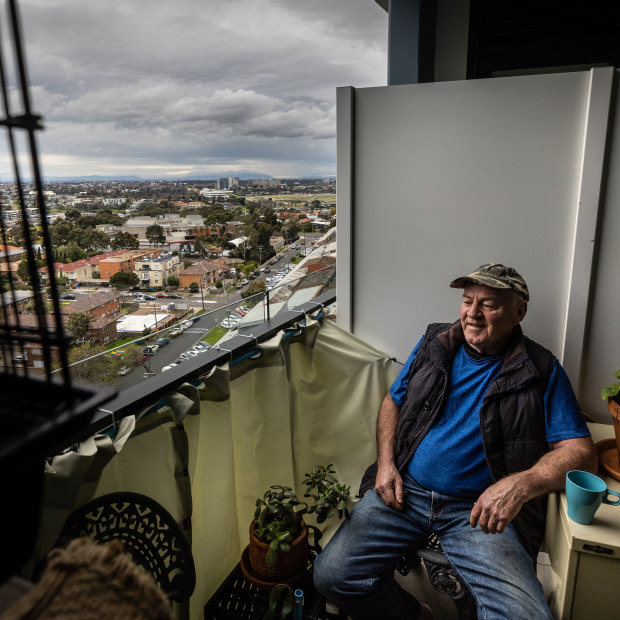
Charlie WheelerCredit: Jason South
The pandemic changed Charlie Wheeler’s life. Wheeler, who has spent time in prison and has been homeless for 20 years, was sleeping in a box trailer under a bridge in Footscray when COVID-19 started.
But an unprecedented need to house the homeless meant he was one of 4500 Victorians put up in hotels during lockdowns to slow the spread of the virus.
Almost a year ago, he was moved into his own home.
The house-proud 63-year-old shows us his flat in Footscray with its sweeping views over Flemington Racecourse.
There’s the bedside table he bought for $5 from Savers. There’s an elegant cream couch with striped cushions that was a steal at $40 from the Inner West Buy Swap Sell Facebook page. A toucan tapestry is on the wall and there are several pot plants he bought from Bunnings and then Googled how to make them grow.
“When you’re living in an environment like this, all your negative thoughts just disappear,” Wheeler says.
“You don’t have to feel unsafe of being stabbed and all this mad stuff. Here, security is spot on. No one can get in that door unless I press a button. I can get back to do what I want to do. I can read my Bible now. You know what I mean?”
Within weeks of the World Health Organisation declaring the coronavirus a global pandemic, rough sleepers had virtually disappeared from Melbourne’s streets.
The Victorian government’s rapid response revealed what was possible when reducing street homelessness was made a priority.
Suddenly, it seemed the pandemic had a silver lining: a solution to a problem that had long seemed intractable.
But two years later, increasing numbers of rough sleepers are back on the streets, amid a chronic shortage of social housing and soaring rents and food and energy costs.
Between 226 and 500 people sleep rough on any given night in the City of Melbourne.
A $167 million Victorian program that moved about 2000 homeless Victorians out of hotels and into their own homes – with wraparound support services – has been life altering for people like Wheeler.
But the future of the From Homelessness to a Home program is in doubt, with funding due to expire by the middle of next year.
And the social housing shortage has meant 40 per cent of people in the program are in transitional accommodation with leases that are beginning to expire.
The government has promised they will all be offered permanent social housing by the end of next year.
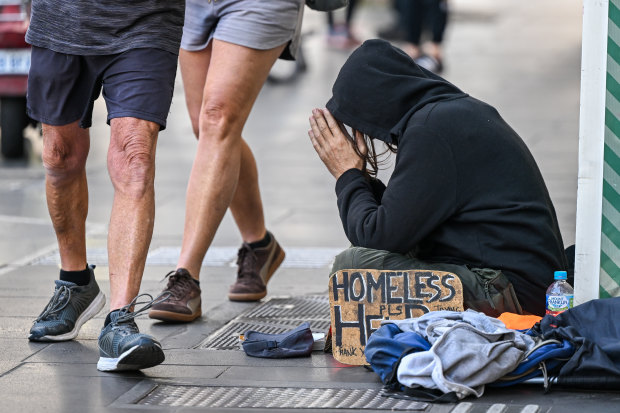
Increasing numbers of people are back on the streets after the pandemic.Credit: Joe Armao
But given there are 55,000 households on the waiting list – and a developers’ levy, that would have meant an extra 1700 social and affordable dwellings a year, has been dumped – many are anxious about the future.
There are fears some will end up back living on the edge: in tents, boarding houses, dodgy motels, caravan parks and on the streets.
Victoria is at a crossroads. Will the political will to end rough sleeping and chronic homelessness be sustained beyond the pandemic?
Utopian dreams
When the Victorian government announced From Homelessness to a Home in July 2020, it was hailed by many in the sector as utopian.
The program was based on a Housing First model, a proven approach to tackling homelessness internationally.
Housing First involves quickly finding someone a stable place to live without the usual conditions, such as requiring them to abstain from drugs or alcohol or comply with mental health programs.
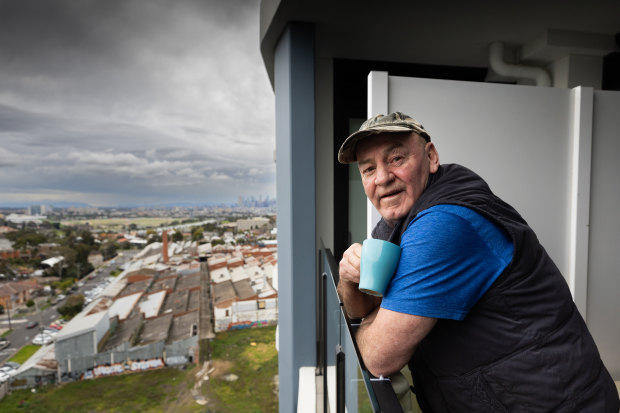
Former homeless man Charlie Wheeler moved into a flat in Footscray after being put up in a hotel during the pandemic. Credit: Jason South
They are then provided with support services, such as drug and alcohol counselling or mental health assistance, for as long as needed.
Where Housing First has been rolled out, including in Scotland, Canada, and Scandinavia, people are more likely to turn their lives around and sustain tenancies.
A 2021 study in the US found that Housing First programs decreased homelessness by 88 per cent and improved housing stability by 41 per cent, compared with treatment-first programs.
Although there have been pilots in Australia, a program on such a scale had never before been attempted in this country.
Last year, the Victorian government commissioned the Nous Group to review From Homelessness to a Home.
The January 28 report, which has not been released publicly but was obtained by The Age, said the program had been transformational for many people.
It said if the housing and support was ongoing, the program could save Victorian taxpayers between $338.5 million and $1.59 billion over 10 years due to a reduced need for justice, health and human services.
But it said a lack of available and appropriate housing meant some people were placed in unsuitable properties that did not work for them or other residents.
Some had to be relocated from luxury apartment blocks following alleged thefts, violence and public defecation.
The review also warned the support packages and a significant proportion of the housing was time-limited, which was likely to undermine the effectiveness of the program.
“All clients in time-limited properties are at risk of exiting back into homelessness unless they have stable housing,” it said.
From Homelessness to a Home differs from a pure Housing First model in one fundamental way: the support packages and 40 per cent of the housing are time-limited.
Due to the lack of social housing, 612 of the 1569 households still in the program as of September 16 were living in head-leased properties that expire after 18 months.
Head-leasing refers to properties leased in the private rental market by the state government and then sub-let at a subsidised rent.
“A major challenge will be securing enough social housing supply for clients who are not able to transition into private rental,” the Nous report says.
The average waiting time for social housing for priority applicants is 15.2 months, substantially above the government’s target of 10.5 months.
From Homelessness to a Home support packages were also only funded for up to 24 months.
“[This] directly contradicts the principle of Housing First that support should be made available with no fixed end date,” the Nous report says.
A spokeswoman for Homes Victoria, the government agency in charge of homelessness, said all people living in head-leased private rentals would receive a long-term social housing offer by the end of 2023.
She said funding had been allocated for those who required ongoing support.
Sophie* lived in her car for 18 months before the pandemic after her relationship broke down due to family violence.
Unison offered her a one-bedroom apartment in Melbourne’s outer west that had been head-leased for From Homelessness to a Home.
But in August, she received a notice to vacate her property in three months. Her Melbourne City Mission case worker assured her they would find her somewhere else to live, but she is rattled.
Sophie is now on the priority social housing list, but as she points out, so are a lot of other people. Her initial optimism she will get a place is fading.
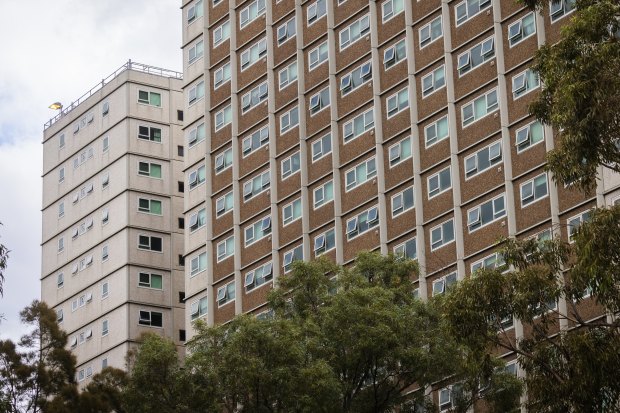
Social housing shortages have been intensified by the pandemic.Credit: Paul Jeffers
When the state budget was handed down in May, there was an outcry from homelessness organisations who warned a $43 million cut to From Homelessness to a Home could leave 1440 people without support.
The government scrambled to find another $23 million to “ensure those in head-leased properties continue to receive support until suitable long-term housing becomes available”.
But the extra funding is only for another year, which has Sophie worried.
“If it’s not extended, we’re all just gonna be back in the same spot that we were in before all this happened. It’s kind of like a Band-Aid solution to make it all look good. Like ‘look at what we did here [during lockdowns] but that’s over now, so fend for yourself’.”
Guy Johnson, a professor of homelessness at RMIT, says the government needs to quickly resolve what will happen to people in head-leased properties.
“You cannot leave this population with that level of uncertainty around their housing. What you’ll start to see is people’s levels of anxiety really start to ramp up,” he says.
“Everyone wants to see this program work, not only for the individuals but to provide a signpost for the way forward for service reform.”
Last month, Homes Victoria chief executive Ben Rimmer said he was going to cut to the chase. “We do know what it takes to end homelessness,” he told a national homelessness conference. “It does require a hell of a lot of additional social housing.”
Levy dumped
Victoria has underinvested in social housing for decades.
The latest Australian Institute of Health and Welfare data reveals a decline in the proportion of social housing in Victoria since 2014, from 3.5 per cent of all households to 2.9 per cent in 2021.
In late 2020, the Victorian government announced 9300 new social housing dwellings over the next four years, as part of a $5.3 billion Big Housing Build. This was the biggest investment in social housing in the state’s history.
But the government later reneged on an $800 million annual developers’ levy – which would have funded an extra 1700 social and affordable homes each year – after the property industry railed against it. Afraid of a scare campaign ahead of the November election, it nixed the levy less than two weeks after it was announced.
“This was a sad, sad day,” says Council to Homeless Persons chief executive Jenny Smith. “The Big Housing Build ends in 2024. Scrapping the levy bombed the pipeline [of social housing] and there is no plan B of which I am aware.”
Former housing minister Richard Wynne recently confessed he was “heartbroken” and yet to recover from the decision to dump the levy.
“We were going to completely change the way housing was delivered, and I was dudded,” he told The Age.
On Tuesday, the Property Council appeared to soften its position, calling for incentives for private developers to create more affordable housing units across Victoria and advocating a scheme in which developers could potentially contribute to the costs.
But Wynne’s successor as housing minister, Danny Pearson, stresses there is no plan to revisit the levy.
“It’s gone, the government has been really clear about that,” Pearson says. “I’m not interested in re-fighting battles that have occurred in the past.”
Asked where the pipeline of social housing will come from without the levy, Pearson points to the potential of athletes’ hubs in Geelong, Bendigo, Ballarat and Gippsland, a proportion of which could be converted to social and affordable housing when the 2026 Commonwealth Games have concluded.
He is also optimistic about more help from the federal Labor government, which has promised to set up a $10 billion fund to build 30,000 social and affordable housing units nationwide.
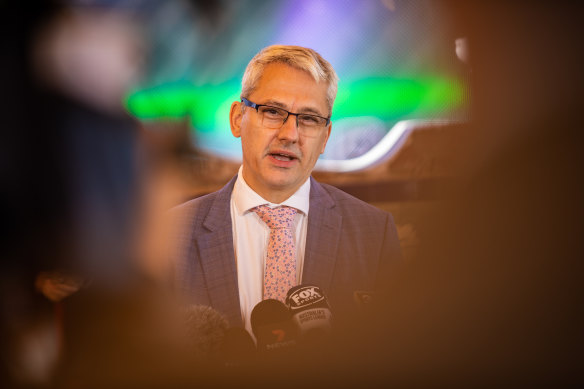
Housing Minister Danny Pearson says there is no plan to revisit the decision to scrap the developers’ levy.Credit: Scott McNaughton
The Nous report recommends From Homelessness to a Home be incorporated in a blueprint to reform the system. This, it says, would address the risk that it ends up being a one-off investment.
The Council to Homeless Persons is hoping for an election commitment to expand the program to include more people and maintain funding for those already in it.
“Otherwise, everybody in a way has wasted their time,” Smith says. “The vast majority of these people need ongoing support. It’s crazy not to keep it going. You can’t say you’re doing a Housing First program and say it’s time-limited.”
The minister says that when faced with a deadly pandemic, the government had to work fast to support people sleeping rough.
“While some things didn’t work out, we got a lot right. We’ve picked up the things we got right and are using these to shape our reform agenda, which is backed by $75 million in funding.”
He says From Homelessness to a Home was always meant to be a “safe harbour”.
“It was transitional housing, they weren’t going to stay there forever. It was about trying to find a way where people can move into more secure housing.”
Pearson says rough sleeping is “in your face” but the magnitude of the homelessness problem is much greater. Many forms are hidden: the young people who couch-surf, the older women who sleep in their cars.
In 2018, for example, there were about 1100 people sleeping rough in Victoria. This made up just 5 per cent of the state’s homeless population.
While From Homelessness to a Home has been successful, Pearson says, rough sleeping is just one area of homelessness to which the government needs to allocate resources.
“For us, it’s about recognising that we’ve got to look at the broad problem.”
No hope
Susan, who has been on and off the streets for nine years, sits on a sodden blanket outside the IGA Express at the top of Lonsdale Street, holding her diabetic dog, Sandy. Her face is mottled with dirt and her ankles are bare. Sandy chewed up her last pair of socks, she says, and now it’s sleeting.
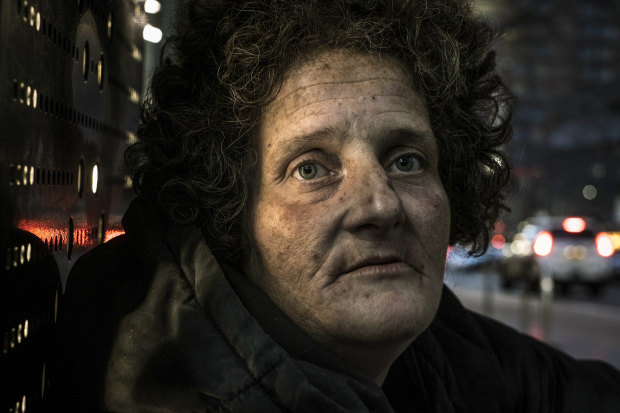
Susan, who has been sleeping rough for years, is worried she will leave the streets in a coffin.Credit: Chris Hopkins
Susan has chosen this spot deliberately. Partly, it’s because the IGA owner keeps an eye on her so she doesn’t get robbed by junkies, but also because it’s opposite the Department of Families, Fairness and Housing.
“I’m protesting,” she says. “We need more government housing. The way cost of living is going up, it’s just going to get worse.”
Susan sleeps in parks, alleyways, car parks, anywhere on the outskirts of the CBD that is dry.
“When you get drunks peeing on you on a Friday and Saturday night, you’d understand why I don’t sleep in the city any more. You can’t call this living, I am barely existing. And every day, you feel a little bit more invisible to society.”
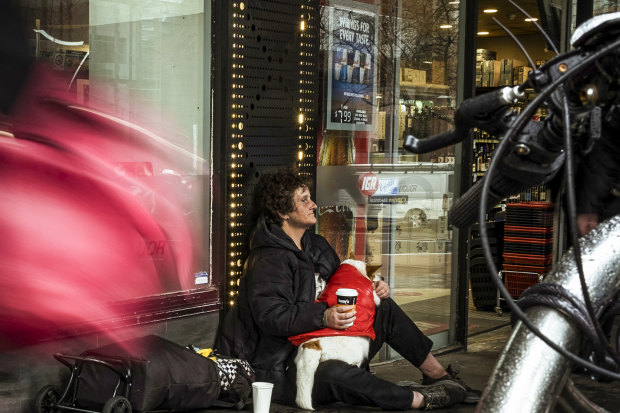
Susan with her dog, Sandy. Credit: Chris Hopkins
The last time she lived in a house was six years ago. “And then I got booted because my ex found me. That’s the problem I have, my ex keeps finding me.”
A couple of homelessness housing providers are trying to help, but Susan has given up hope of a home.
“The only way I could really see myself getting off the street permanently is in a coffin.”
*Not her real name
The Morning Edition newsletter is our guide to the day’s most important and interesting stories, analysis and insights. Sign up here.